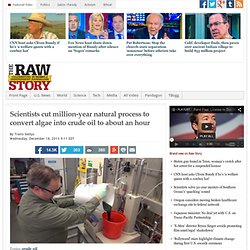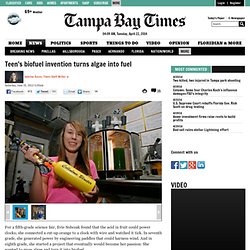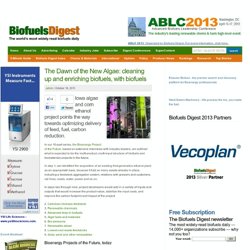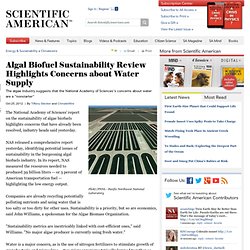

Scientists cut million-year natural process to convert algae into crude oil to about an hour. By Travis GettysWednesday, December 18, 2013 9:11 EDT Engineers have sped up a naturally occurring process to make crude oil from algae from about a million years to just minutes.

Researchers at the Department of Energy’s Pacific Northwest National Laboratory pumped a slurry of wet algae into a chemical reactor, which then subjects the biological material to very hot water under high pressure to tear it apart and convert it into liquid and gas fuels. The resulting crude oil can then be conventionally refined into aviation fuel, gasoline or diesel fuel, the researchers reported in the journal Algal Research. The team’s experiments converted more than 50 percent of the algae’s carbon into crude oil, sometimes up to 70 percent, in about one hour and created nothing more hazardous than an odor of dirty socks, rotten eggs and wood smoke from the processed biological material. Teen's biofuel invention turns algae into fuel. For a fifth-grade science fair, Evie Sobczak found that the acid in fruit could power clocks; she connected a cut-up orange to a clock with wire and watched it tick.

In seventh grade, she generated power by engineering paddles that could harness wind. And in eighth grade, she started a project that eventually would become her passion: She wanted to grow algae and turn it into biofuel. After four years of tinkering in her garage for about an hour each day, Sobczak (pronounced sob-chek) has finally figured it out. Algae Street Lamps. Sunday, 08 April 2012 GreenMuze Staff Algae Lamps from Shamengo.

French biochemist Pierre Calleja has created large-scale algae powered street lamps that can potentially absorb more than one ton of CO2 a year. Algae lamps can charge up batteries during the day through their photosynthesis process that is driven by the sun and nutrients. This stored power is then used at night to power lights. Calleja’s lamps can also be illuminated artificially, such as in dark underground parking lots, where the algae go to work absorbing all the CO2 emissions from the cars. Maybe a forest of these algae lamps in every city might go a long way to replace all the CO2 absorbing trees that got cut down to make way for urban sprawl. <div style="background-color:red;color:white;width:160px"><strong>JavaScript is disabled! News Blog: Algaeus lives! A modified Prius goes cross-country on fuel from algae. Algae. Biochemist Dan Robertson's living gas stations have the dark-green shimmer of oak leaves and are as tiny as E. coli bacteria.

Their genetic material has been fine-tuned by human hands. When light passes through their outer layer, they excrete droplets of fuel. "We had to fool the organism into doing what I wanted it to do," says Robertson, the head of research at the US biotech firm Joule Unlimited. He proudly waves a test tube filled with a green liquid. The businesslike biochemist works in a plain, functional building on Life Sciences Square in Cambridge, Massachusetts. His laboratory is sparsely furnished and the ceiling is crumbling. Scientists rave about a new, green revolution. The Dawn of the New Algae. Iowa algae and corn ethanol project points the way towards optimizing delivery of feed, fuel, carbon reduction.

In our 10-part series, the Bioenergy Project of the Future, based on extensive interviews with industry leaders, we outlined what is expected to be the multi-product, multi-input structure of biofuels and biomaterials projects in the future. In step 1, we identified the acquisition of an existing first-generation ethanol plant as an appropriate base, because it had so many assets already in place, including a feedstock aggregation system, relations with growers and customers, rail lines, roads, water, power and so on.
In steps two through nine, project developers would add in a variety of inputs and outputs that would increase the product value, stabilize the input costs, and improve the carbon footprint and impact of the project. 2. Cellulosic biomass feedstock 3. Bioenergy Projects of the Future, today The Algae Option It’s all still at relatively small-scale. Next steps. Microalgae Lamp Absorbs 150-200 Times More CO2 than a Tree! Algae-Powered Building. The world’s first algae-powered building just opened in Hamburg!

Dubbed the BIQ House, the project features a bio-adaptive algae facade and it will serve as a testing bed for sustainable energy production in urban areas and self-sufficient living buildings. International design firm Arup worked with Germany’s SSC Strategic Science Consultants and Austria-based Splitterwerk Architects to develop the BIQ House, which launched as part of Hamburg’s International Building Exhibition. Algae Street Lamps. Cal Poly Project Produces Energy and Purifies Water Using Algae and Human Waste. Photo via Shutterstock The Keystone XL pipeline has some big competition, and it is coming from a number of very small challengers.

Scientists at Cal Poly in San Luis Obispo, CA are working under a $1.3 million grant from the Department of Energy to produce biofuels from algae and human waste. Instead of relying on dirty tar sands and massive amounts of energy to extract and transport the viscous petroleum, algae needs only the contents of a toilet bowl and some sunlight. The algae not only helps to clean municipal waste water efficiently and inexpensively, but takes advantage of a basically free source of food for the microorganisms to grow.
Governments are able to meet the rising costs of removing impurities from water, provide green jobs, and avoid scarcity issues related to using water to grow biofuel crops or fracturing shale. The Cal Poly team, also known as the Algae Technology Group (ATG), was established in 2006 to research biofuels and water reclamation. Via Clean Technica. Scientists cut million-year natural process to convert algae into crude oil to about an hour. High Density Vertical BioReactor Could Create Custom Biofuel From Algae. Glen Kertz talks about the advantages of high density vertical bioreactors.

The Holy Grail in the renewable energy sector has been to create a clean, green process which uses only light, water and air to create fuel. News Blog: Algaeus lives! A modified Prius goes cross-country on fuel from algae. Algal Biofuel Sustainability Review Highlights Concerns about Water Supply. The National Academy of Sciences' report on the sustainability of algae biofuels highlights concerns that have already been resolved, industry heads said yesterday.

NAS released a comprehensive report yesterday, identifying potential issues of sustainability in the burgeoning algal biofuels industry. In its report, NAS measured the resources needed to produced 39 billion liters -- or 5 percent of American transportation fuel -- highlighting the low energy output. Companies are already recycling potentially polluting nutrients and using water that is too salty or too dirty for other uses. Sustainability is a priority, but so are economics, said John Williams, a spokesman for the Algae Biomass Organization. "Sustainability metrics are inextricably linked with cost-efficient ones," said Williams.